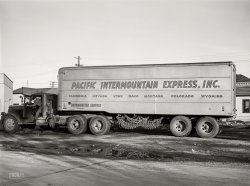
MAY CONTAIN NUTS

Search Shorpy
SHORPY ART

Framed or unframed, desk size to sofa size, printed by us in Arizona and Alabama since 2007. Explore now.
Join and Share
Ad-Free Shorpy
Shorpy is funded by you. Patreon contributors get an ad-free experience.
Learn more.

Recent comments
- Famous Hollywood faces
- Not just S&P
- re: Those things in the jar
- Up In Smoke
- Medical Smoking
- Quick fix
- A Quink Comment
- If You’re Like Me, Never
- Delivering the News
- U.S.A.
- S&P
- 1940 Zenith radio model 6G601
- Quality goes in before the name goes on!
- Snazzy skirt
- Carbon Arc Lamps
- Illuminate us
- I remember it well
- I can't prove it
- Complicated then, forgotten now
- Bryan-Stevenson
- Skinny is as skinny does
- How do you rest in peace
- Riding the footboards
- Alas, hidden from view
- Baldwin Diesels
- Exclusive pump
- Bananas, Oysters and Smokey Joe
- Details, Details
- What's that building to the left of the tower?
- Coal Barges
Member Photos
The Shorpy
Print Emporium
Print Emporium
Search Shorpy
Search results -- 30 results per page
- The Toyopet Kid: 1960
- ... in January 1960. Full disclosure: it's my brother's unlit pipe and I'm not driving. I'm in a parked 1960 Crown Custom at Hil Probert's ... was corked with rubber stopper on a nylon string.
The pipe was a nice touch I never pictured your house on a hill. Maybe I got ... Posted by tterrace - 06/24/2009 - 5:01pm -
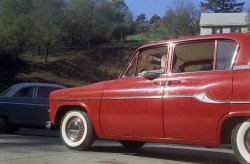
- The Modern Kitchen: 1920
- ...
Two Kitchen Questions 1) What is the purpose of the pipe-shaped apparatus on the upper and lower portions of the front of the ... are nickel-plated gas lines. The valves screw into that pipe and are adjustable. The bell shape in front of the valve is part of the ... Posted by Dave - 07/23/2012 - 3:39pm -
![The Modern Kitchen: 1920 Washington, D.C., circa 1920. "Kitchen of Ernest G. Walker," newspaperman and real-estate developer. Harris & Ewing Collection glass negative. View full size.
Magnesite FloorThe kitchen floor is [or at least could be] a waterproof concrete-like product called magnesite, and has continuous mop boards molded in to facilitate easy cleaning. Magnesite was a popular choice for upscale kitchen and other utility floors in the teens and twenties, and was also used for kitchen counters and even sinks. The Will Rogers Ranch House in Malibu still has its magnesite kitchen counters, which are an attractive pale doeskin color. It was also tinted with pigments and scored to look like quarry tile flooring in 1920s houses. My Materials Handbook defines it thus: "A flooring material composed of calcined magnesite, magnesium chloride, sawdust, ground quartz or silica, and fine powdered wood waste; used as a finishing surface on concrete floor slabs."
Two Kitchen Questions1) What is the purpose of the pipe-shaped apparatus on the upper and lower portions of the front of the range? It doesn't appear to be part of the gas line.
[They're bumpers that protect the valves. - Dave]
2) What technological or inspirational leap was required to create a single spigot on a kitchen (or bathroom) sink that would handle the outflow of both hot and cold water and — mercy me! — allow them to mix as warm as well? I've always wondered this in connection with older plumbing.
Bonus question: In the jar on the side table, that's the best Mr. Walker could do for flowers?
Modern TimesI wonder what material is on the two tables. It looks to be tacked down to the one on the left and draped over the one next to the stove. If I didn't know better, I'd say it was vinyl....but I know better.
Also, I'll bet the ice box is on an exterior wall and the top right door is for ice. It was popular at this time to have an ice door on the outside of the house that fed directly in to the ice box. The delivery man could put in a new ice block without even knocking on the door.
Ahhh, modern conveniences.
Curious Interesting to note that the gas oven is vented to the outside. And we've sure come a long ways in flooring, haven't we?
State-of-the-art technology!I hope that the beautifully tidy kitchen, the flowers on the table, and the satisfaction of a state-of-the-art Chambers stove helped that poor woman's quality of life, wearing that ratty apron and those pinching boots. Apparently, this must have been taken in the late 20s:
http://www.oldstoveman.com/contents/media/chambers%20fireless052.jpg
The Chambers logo changed sometime in the 20s from triangular to circular.
[Below, an ad from September 1920 showing a Chambers stove with the round logo. - Dave]
I'm Amazed....how many gas stoves and ovens seen in the pictures from this era, are connected to a chimney flue. Modern gas stoves do not connect to a chimney flue or any vent.
["Gas" back then meant coal gas, which was poisonous. - Dave]
CookingThis is the very model of the modern kitchen, indeed. They have two cabinets full of china, a phone, AND a light over the sink. I wonder what's in the double-boiler-y thing next to the clock. I can't tell if she's making breakfast or dinner -- I wish I could see what she's doing.
On the TableProbably oilcloth -- cotton or muslin impregnated with linseed oil.
Ummmmm!I wonder what she's preparing, betcha it was yummy.
Wish my stove was that multi-functionalShe's got two separate ovens, broiler, and I'm guessing bread/plate warmer at the top. Me want. Although this oven/range would never pass code today. There is a fella somewhere in Pennsylvania that retrofits these antique stoves. And they sure ain't cheap.
Oh, and love the amount of cabinet space too.
Interesting KitchenI found a few interesting items. The box on the wall beneath the phone appears to be some sort of primitive intercom system. Above the doorway there is another box which may have some sort of bulb or light cover protruding from its left side, about a foot away is a bell. Could this have been an alarm of some sort? Also, I sold plenty of Chambers gas ranges back in the 1950s and 60s. They were a high end product and like the Blackstone Washer it probably weighed 100 pounds more than a Caloric or Tappan. Chambers competition was the Crown Gas Range. Crown would custom build ranges for their end users and they would come with an engraved escutcheon inscribed with the family's name.
Odds and EndsLooks as though the kitchen has all the mismatched china and a couple matching serving pieces. The matching set, which still may be everyday china are in the hallway or service porch with the icebox.
Big Japanese VaseThe very large vase standing next to the ice box is a late 19th Century Japanese "floor vase." Many of these were sold by Japanese importers at the numerous American world's fairs between 1890 and 1916, and some of them were as large as six feet tall. They were often displayed in the corners of American dining rooms with tall flowers, peacock feathers or pampas grass fronds. Here is a similar but slightly smaller version from one of the Imari kilns.
Intriguing StoveThe gas plumbing for the stove is really interesting. Two of the ovens have the usual small valve with the porcelain knob, plus a much larger lever below that's held off by (presumably) the safety bumpers. What would they be for? An extra-large flame for preheating? The third oven (warming oven?) doesn't seem to be adjustable.
I noticed in a previous post that manuals are still available for this stove. But my curiosity didn't extend to $15.
Cooking with gasI've owned and restored a few stoves similar to this one. The pipes on the front are nickel-plated gas lines. The valves screw into that pipe and are adjustable. The bell shape in front of the valve is part of the burner and is where you make the air adjustment. In good condition, old stoves like this one still work very well.
Proper attireI don't see a "ratty apron" or "pinchy shoes." The apron just looks like it is performing its natural function as an apron and her shoes just look like shoes. The cook's workplace was clean and well-fitted and her job was certainly important.
Being a cook in a kitchen like this was not a horrible job. My Irish grandmother was a cook in just such a kitchen, working for an aristocratic lady. I knew her years later when she worked quite happily in her own smaller kitchen. And her apron always looked used! And she always wore leather shoes - no sneakers for her!
That black round thinghanging on the corner of the stove . What is it?
OilclothBack during WWII I spent my school vacations working on an ice wagon and many is the 50 pound chunk of ice I have placed in boxes like the one in the picture, but I never saw one that loaded from the back side. I remember one that I had to fill from the top. A lot of people out on rural routes did not even have an ice box but used a #2 galvanized wash tub to store their ice in. They had quilts in there as insulation and generally bought no more than 25 pounds at a time. 25 pounds sold for 10 cents as I remember it.
The table covering is another of those vanished items from the 1920s and earlier -- oilcloth. I can still smell it to this day. Not an unpleasant odor and quite serviceable. I have a Confederate cavalry sabre that has an oilcloth-covered handle wrapped with iron wire. My Rebel forefathers had to use oilcloth because leather was needed for horse harnesses, revolver holsters etc.
More about ValvesAfter zooming quite a bit to the stove hardware, I don't think those extra levers are valves at all, but simply latches for the burner-valve guards. Moved in the opposite direction to the one shown, they'd latch the burners off, a good idea since the valves are at small-child height.
The third of the vertical ovens does indeed appear to be adjustable, but missing its porcelain knob.
And the big can above the burners, brethren, is a cistern. For hot (well, warm) water. It made use of waste heat from the stove.
[Actually they are heat-retention hoods. See above. - Dave]
Not Always ExpensiveI cook every day on a 1934 Magic Chef I bought for $120. I'm the second owner and it has never been restored. I think the key to its longevity is the fact that it was never out of use, it was well cared for, and very well made. It easily weighs 3 times as much as a modern stove of similar size. It is packed with asbestos, so it holds heat well.
Also, I have a 1926 duplex with the Magnesite floors just as described, in the bathrooms. The floors are indestructible. Why they ever stopped installing them, I have no idea.
Cooking HoodThe big can above the burners is a fuel-saving device. It's an insulated hood which could be lowered over the burner once the pan was up to cooking heat, allowing the burner to be turned off an cooking to continue using the "stored heat" in the pan. Not sure how well it worked.
[A colorful theory, but how would that work for pots and pans with handles? As noted below, the cans are hot-water reservoirs. - Dave]
[Actually Sooty is right on the money. - Dave]
Cooking Hood AgainPages 2-5 of the installation instructions explain everything.
[Sooty is correct! And I am corrected. - Dave]
Cooking with the gas turned offChambers Gas Ranges had insulated ovens that let you "cook with the gas turned off." Example: a stuffed 12 pound turkey in a roaster; put in a cold oven. Run the gas on full for 45 minutes. Shut off the gas and flue to keep the heat in (lever on front of each oven near the gas pipes). The turkey will continue to cook from the retained heat and in three hours you have a great meal ready. It saves fuel cost and unlike modern stoves, the food is not dried out from being cooked with the gas burning all the time.
[What keep the roast cooking is radiant heat from the cast iron enclosure. Which has more to do with mass than insulation. In modern ovens, the gas isn't on all the time. The thermostat shuts it off once cooking temperature is reached. - Dave]
The black cylindrical apparatus over the back left burner was a Thermodome. You lowered it over a boiling pot to continue cooking with the gas turned off.
Chambers 1927 "Idle Hour" Cookbook:
http://www.vintagechambers.org/pdfs/IdleHour1927.pdf
Avon callingThe two "alarms" above the doors are doorbells. Presumably one for the front door and the other for the side or back door which would be the tradesman's entrance.
The maid or housekeeper would answer the phone and the doorbell in a home like this which is why the bells and phone, including the switching box to send calls up to other parts of the house, are in the kitchen.
Weeds of LoveFor time immemorial children have brought their mothers, grandmothers, nannies, mammies and cooks "flowers" (i.e. weeds) from the yard to say "I love you," and these women have put them in drinking glasses or canning jars on the kitchen table.
Hot and ColdMy 1928 bathroom sink has separate taps for hot and cold water. Old hot water systems often flowed at a slower rate than the cold water supplied from the main to the house. The reason the two were not combined into one spigot was because the stronger cold water pressure could cause the hot water to flow backward.
I have been cooking on a 1940 Beach (Canadian) gas stove since I bought it in 1970 for $25. Super baking oven, and the broiler is in the oven, rather than in a drawer under it. The one-piece cast iron top weighs 15 pounds. The trash burner next to it also provides hot water to a radiator in the front hall.
Her NameIt makes me sad that so many of these old photos fail to identify the Black people in them, so I spent a few hours researching the woman pictured here.
Her name is Elizabeth Bagley according to the 1920 census. She was born in Virginia and is a 75 year old widow working as a cook at 1522 R Street NW (as noted, the home of Ernest G. and Romaine Walker)
The 1910 census spells her name "Bagby" and says she is 60 years old.
(The Gallery, D.C., Harris + Ewing, Kitchens etc.)](https://www.shorpy.com/files/images/20740a.thumbnail.jpg)
- Uneeda Biscuit: 1911
- ... sloganeering will ever turn Byers Full Weight Wrought Iron Pipe into an impulse purchase.) Detroit Publishing glass negative. View full ... the entrance for the Detroit-Windsor Tunnel.
Byers Pipe Was a product of the A.M. Byers Company in Pittsburgh. Here's a photo ... Posted by Dave - 03/25/2022 - 2:30pm -
![Uneeda Biscuit: 1911 Detroit circa 1911. "National Biscuit Co." Manufacturers of the once-ubiquitous Uneeda Biscuit as well as its obliviated sibling, the Uneeda Jinjer Wayfer. (Proximity notwithstanding, something tells us that no amount of glib sloganeering will ever turn Byers Full Weight Wrought Iron Pipe into an impulse purchase.) Detroit Publishing glass negative. View full size.
Shorpy is my daily time travelI love this website. Notice the slightly less concise version of "Got Milk?" -- "Do you know Uneeda Biscuit?"
Ubiquitous ... or "ubiscuitous" ??If you were patient and hung around, the next year — i.e. 1912 — you could have a package of "Leap Year Jumbles" (Hopefully NOT available in a titanic-sized box)
And if you were really patient, and hung around for 17 years, you'd see this block (of Woodbridge Street) demolished to provide the entrance for the Detroit-Windsor Tunnel.
Byers PipeWas a product of the A.M. Byers Company in Pittsburgh. Here's a photo of the still standing Byers Mansion - actually two dwellings, one for him, one for his daughter's family - on the former Allegheny City Millionaires' Row. Note the wrought iron gates.
Look Ma, no wires!It's interesting in some photos showing downtown scenes, you see overhead wires crisscrossing all over the place but in the last few Shorpy pictures, you really don't see any! I guess they were buried under the streets.
[There's a smattering of wires here that the Detroit Publishing people retouched out of the negative. - Dave]
Marketing issue resolvedGottaHava Cast Iron Pipe.
(The Gallery, Detroit Photos, DPC, Factories)](https://www.shorpy.com/files/images/SHORPY-4a21050a.thumbnail.jpg)
- Nightline: 1920
- ... or if he fired a track pistol.
Criminal Mastermind? Pipe the swell on the far right, gazing levelly at the camera. Oh, he's a cool ... who have absconded with our retirement accounts).
Pipe the swell What in the hell does pipe the swell mean?
[Pipe = ... Posted by Dave - 08/06/2012 - 1:54pm -
![Nightline: 1920 "Election night crowd at White House, November 1920." The chosen one was Warren Harding. National Photo Company glass negative. View full size.
Mrs. WethenThe very indignant lady at the far left takes a wonderful picture! Mother of the loser?
Patiently waiting for the black or white smokePatiently waiting for the black smoke or white smoke. Incredible resolution, is it a 8 x 10 plate?
[6 x 8, seen here at one-quarter resolution in the "full size" view. - Dave]
Ia! Ia! Shub-Niggurath!It's the so-called "Innsmouth look". I hear it's all the rage this year in Arkham, Massachusetts.
Whoa...Check out the fourth guy from the left and his bulging eyes. Must have been a tense night.
Top ThatNot a hatless head in the entire crowd. And no man without a necktie. Wow.
Deer in the HeadlightsIt's surprising just how many people in this crowd are looking straight at the lens, and if startled to attention by the photographer, and just in time to lose their night vision for a few minutes to a burst of flash powder. I wonder what he said, or if he fired a track pistol.
Criminal Mastermind?Pipe the swell on the far right, gazing levelly at the camera. Oh, he's a cool one, all right.
KnickeredAt what age was it customary for boys to stop wearing knickers and put on their "big boy pants" like their fathers? The boys in this photo look to be in their teens.
Holy cow!Just about everybody in this alarming photo looks as if they'd "fit the profile" by today's tense standards. Were they all arrested just minutes later?
Jeepers CreepersStartled looks on some of them, indeed, Tipster. The Charles Boyerish fellow fourth from the left, in particular, has a whole lot of eyeball going on.
Not a slob in the entire crowdAs a previous poster mentioned, every single person in attendance is presentable, indicating respect for the occasion. Psychologists believe that well-dressed people also behave better and usually obey the law more conscientiously. (Tell that to Bernie Madoff and all the other white collar crooks who have absconded with our retirement accounts).
Pipe the swellWhat in the hell does pipe the swell mean?
[Pipe = slang for "look at." - Dave]
Hi-ResThe high resolution/quality really makes me appreciate the content on this one. It would be impossible to make out all these disgruntled faces on a picture half the size. One of the things I've always admired about Shorpy is not only the interesting subject matter, but the high quality of the images themselves. This is a shining example.
Hey CopperI love the look of the cop on the left, nightstick ready for those who may step out of line. Didn't they carry guns back then?
(The Gallery, D.C., Natl Photo, Politics)](https://www.shorpy.com/files/images/29585u.thumbnail.jpg)
- Surratt House: 1900
- ... the left, top floor dormer, he man may be holding a long pipe or a pen. The bits of daily life are what fascinate me about many of these ... and many other cities started in the 1870s. - Dave]
Pipe Up The man in the dormer is smoking a "churchwarden" pipe.
Better ... Posted by Dave - 07/24/2012 - 7:13pm -
![Surratt House: 1900 Circa 1900. "Mrs. Mary Surratt house at 604 H Street N.W., Washington." Boardinghouse owned by Mary Surratt where the Lincoln conspirators are said to have plotted the abduction of the President in 1865. Brady-Handy Photograph Collection glass negative, Library of Congress. View full size.
A watched totDon't overlook the people in the windows. The person on the right, bottom floor just behind the steps, seems to be taking a bite of something while in the house on the left, top floor dormer, he man may be holding a long pipe or a pen. The bits of daily life are what fascinate me about many of these pictures.
GuiltyMary Surratt was the first woman executed by the United States government, less than three months after the Lincoln assassination. Her death set off controversy that lasted over a century, but today there seems little doubt that she was closely involved in Booth's conspiracy. Ironically, her son John Surratt Jr. escaped the 1865 fury over Lincoln's death by fleeing the country; he was eventually captured and tried, but released after a mistrial and lived to be 72.
You want MSG with that?Surratt House has morphed into the "Wok N Roll" restaurant in D.C.'s Chinatown. There is a plaque.
View Larger Map
Mrs. SurrattAs she was lead up the gallows and positioned over the trap door, she kept pleading "Please, don't let me fall."
I've always wondered if she was referring to the height or the drop from the hangman's lever?
However she may have meant it, she fell.
The StreetWere the roads paved in this era? When did widespread road paving begin in cities?
[The street in this photo is paved with asphalt. Asphalt paving in Washington and many other cities started in the 1870s. - Dave]
Pipe UpThe man in the dormer is smoking a "churchwarden" pipe.
Better in 1900The two buildings looked better in the 1900's than they do today. In the picture of the buildings today you can see where they took the stairs out and changed the entrances. Looks pretty dumpy now.
I am surprised...that this building has not been acquired as a national historic treasure by the Government. Whether or not you sympathize with what Booth et al did in 1865 to President Lincoln and his Cabinet, this structure should be preserved and restored to its appearance in April 1865.
"Chriswarish"That photo looks like a Chris Ware illustration, including the boy!
Surratt House on the BlockThe Surratt House was added to the National Register of Historical Places in 2004.
Washington Post, Mar 24, 1922
Lincoln Death-Plot
House Goes on Block
Surratt Home, Rich in HIstorical Past,
Fails to Bring Satisfactory Figure, However
A three-story brick house, once one of the proudest and most pretentious in the city, and rich in historical past, was placed on the auction block yesterday afternoon. It was the home of Mrs. Mary Surratt, who was executed for her alleged share in the assassination of President Lincoln, and stands at 604 H street northwest.
A crowd of morbidly curious had gathered to watch the proceedings when the auctioneer unfurled his red flag and started to work. There were a few bidders, but it took some time for the auctioneer to work the price up to any considerable figure. The best offer received, $9.700, was considered too small, however, and the auctioneer announced that the house would be sold to a man who had privately offered $10,000.
The old house, recently painted a dark gray, seemed forlorn. The steps that many years ago had led to what is now called the second story had been removed, and the entrance was on the sidewalk. Where the steps once led into the house, there was a door that had been closed many years. In and out of it at one time had gone men and women whose deeds were to shake the foundations of the country.
Mrs. Surratt used the house for many years prior to 1865 as a boarding house. It was in the little parlor on the second floor that the Lincoln conspirators met and planned the martyred President's death. Mrs. Surratt was buried in Mt. Olivet cemetery, near the west fence.
My ancestral homeThanks for the great photo. My great-grandma and her family lived in this house in the 1880s. The story goes that they moved because of the nuisance of souvenir hunters coming by and trying to take a piece of the house. Their next address was 606 H; so would this be the house next door I wonder?
+116Below is the same view from June of 2016.
Streets RenumberedSometime after 1880 the streets were renumbered. This house was originally 541 H Street at the time of the assassination, and later became 604 H Street.
(The Gallery, D.C., Kids)](https://www.shorpy.com/files/images/03432a.thumbnail.jpg)
- Shop Early for Xmas: 1922
- ... or I'm missing something very obvious and it's a water pipe or something.
[It's the decoration (or alarm tape, which did indeed ... Posted by Dave - 11/06/2015 - 12:35am -
![Shop Early for Xmas: 1922 Washington, D.C., circa 1922. "Sport Mart, 1303 F Street N.W." Shorpy would like one of each, please. National Photo Company glass negative. View full size. Update: For the window-shoppers among us, I've posted a bigger closeup here.
Lionel Train SetThat Lionel Electric Train Set is to die for!! I know fellow collectors who, if they had only the original box displayed in this picture, would be in fandom heaven. Joshua Lionel Owen invented the first toy trains in 1901 so New York City Department Stores could use them for window displays during Christmas. The rest as they say is history. Great picture. Also, just can't imagine any store having all those guns in a front window anymore, with just plate glass in front of them as protection from theft. Were people really that honest back then?
Don't bother with the girlsLove all the signs. Also interesting to see another pre-WWII swastika, and this one is even turned 45 degrees onto a point, the same as the Nazis did.
[That's two interlocking S's, for Stetson Shoes. Ten lines. A swastika has six. - Dave]
Airguns $1I'm sorry, Shorpy, you don't want that. You'll put your eye out.
Western Auto, Carroll Cut Rite....In the small mill town where I grew up, we had the two stores mentioned as well as United Cigar and Hart's 5 & 10. Their windows examples of just about every single item in inventory. The multitude of tiered shelves allowed one to see what was inside without actually going in. For the kids (like me) that had a total of $10 to buy six gifts, it was great to stand in front of the window and budget out the allotment, figuring out who would get what before actually buying. Mom always got the blue bomb bottle of Evening in Paris or dusting powder, Dad got something in Old Spice, an inflatable toy for my baby brother, handkerchiefs or an autograph book for Sis, etc. Christmas will never be as meaningful as when we had to budget every cent because it really meant something more than just purchasing merchandise.
I'll take the...Kodak Autographics, bike and Lionel train sets, please!
Santa Please......bring me the sled that looks just like Rosebud, and the Lionel trains, and the golf set with those fabulous hickory shafts. I need a new niblick.
Alice MaynardOne wonders what Alice Maynard is selling "upstairs." Probably entirely innocent - probably ladies clothing based on what we can see in the second floor windows - but the filthy mind gets all sorts of ideas.
Can I have the .22 please?That Winchester pump .22 would be worth big bucks if it were in good condition today.
Re: Santa Please...I couldn't help but notice the fatness of the "pre-pass" era type of footballs. More like a rugby or Aussie rules football.
Toy StoryGreat photo, Dave. I can't tell how much the chess set is, but it looks like a nice one. Cowboy suede holsters and Indian feathered headbands would be frowned upon today. I am puzzled why a thermos is more expensive than a golf set. There's so much to look at. By the way, are those irons (the kind for pressing clothes?) What's with that?
[The sign under the vacuum bottles is for a $15 "tackle outfit." - Dave]
I have a pump .22 a lot like the one in the window......but its a "Savage" vs. a "Winchester", octagonal barrel, you can take it apart with one screw. Last fired about 25 years ago!
Not to Nitpickbut it's Joshua Lionel Cowen, ne Cohen. He was the great-uncle of the infamous Roy Cohn, who later was board chairman of the train company.
Fix bayonets!That Daisy BB gun has a bayonet on it -- more fun than lawn darts!
SavageI believe Savage was taken over by Winchester way back when. I had a 1918 Winchester pump as a kid. I really loved it and used it in the late 40's and 50's. Wish I could find another under $1k.
Aw, Why do I have to be a girl?I'm looking at all the really neat stuff in the window. All my friends were boys when I was growing up and their toys were the best. If I lived back then, my mother would have shopped for me one door over to the right, where they have a selection of ugly, boring dolls.
Dreaming of the train set...
.38How long would those pistols last in a glass storefront in 2008? Not long.
Pistols..The pistol on the right is most likely a Colt Model 1903 .32 ACP or perhaps a Model 1908 .380. The Revolver is a Smith and Wesson. I can't identify caliber size or frame type. As to the pistol on the left, your guess is as good as mine.
It's interesting that Washington D.C. in the 1920's where you could buy guns no questions asked at a department store with glass windows was much safer than 21st century D.C. where possession of any one of the firearms in that window was a felony until recently.
What every boys wants...but should he get a revolver?
Oooooh! Oooooh!I was born 25 years later, but in spirit my nose- and handprints are all over that Sport Mart window. I have hundreds of engines and cars in my collection but no Lionel that goes back to the 1920s, much to my sorrow. Dad couldn't wait to put one under the tree, so I had my first one at age 4; at 62 I still play with trains! (Sadly, electric train sales have fallen on hard times and only the old boys are interested.) I do have most of the cameras in that window but they aren't quite so shiny -- but they do work, even the ones going back to the 1870s.
Air rifles weren't allowed in my family (had to play with my friend's guns on the sly) and they sure couldn't be had for a dollar then!
Even the boys in my family spent a lot of quality time using an iron (the ones that put a crease in your britches and made your starched shirts crisp -- not the ones you hit little white balls with) but I don't remember thinking it was much of a sport! Note that the golf balls there are individually wrapped. I don't recognize the bike in the window, but it looks big; in the early 1950s we had a hand-me-down of indeterminate origin, the only 38-incher in the neighborhood.
Not much in the window for the little girls in 1921. The signs seem to indicate they may not have gotten them personally as gifts, but in some families the "tomboys" had their ways! Some things have changed for the better.
A Visit from the Innuendo FairyDon't all "bicycles" have "reputations?" Nudge, nudge, wink, wink, say no more!
ShockingBesides the toys there are bunches of household items on display (but don't get me wrong, I want the train set and a basement to put it in). I'm suddenly interested in the parallel history of the battery and portable electrical devices. Things like flashlights had to have been introduced for the consumer with a battery in mind. Of course after a few years batteries became ubiquitous, but imagine going to a store and picking up a battery and not already owning anything to put it in.
Lionel for ChristmasI had a circa 1941 Lionel freight train complete with all the cars and a headlight. I got it for Christmas. It also had little tablets that you could drop down the stack so that the engine puffed smoke as it tore around the three-rail track. Alas, my dear mom gave it away to Goodwill one day when I was in high school. Sigh!
Indoor SportsSome of the Christmas Specials in this display window bring new meaning to the term Sporting Goods. The lower left section is filled with electric-powered household appliances: Irons, a toaster, a coffee percolator ("perculator" in the sign) and a set of antler-handled carving knives for that Christmas turkey. When I was a kid in the 1950s there were a few moms in our neighborhood who seemed to think that Extreme Ironing was a competition sport, but they usually got their gear at Sears. And what about that accordion in the back row next to the electric space heater?
$16There's a sign just below the sled for $16 but I can't make it out. Can you blow it up?
[Kaboom. - Dave]
Electric TorchJust to feed everyone's new interest in the subject, here's a post from the inimitable Daniel Rutter that includes some early flashlight background.
$5.50 for a dozen golf balls.A lost ball in a water hazard or the rough had to have hurt!
Made In U. S. A.For an advocate of American-made goods which are currently difficult (to impossible) to find for gift-giving, I assume that almost everything in this window was made right here in the USA. A twinge of sorrow takes over as I wonder if Lionel is still made here, or Daisy Air guns or Flexible Flyers. Christmas lights shown here for $8.50 (a huge amount of money in 1921) can be bought today for a couple of dollars. Yes, imports are cheap, cheap, cheap, but also disposable and short-lived. Time marches on and even Levis are made in Mexico, Converse in China. I did find nail clippers made in the USA last week for $1. Maybe I'll be like Jack Benny and give gifts of just shoelaces and nail clippers this year. Don't know of ANY toys or electronics made here. One other non-imported gift suggestion is to give the gift recipient a hand-made gift card for FOUR HOURS of personal advice. (few people will cash it in) Merry Christmas fellow Shorpy addicts.
Get the boy something he wants...All he wants now is a Wii, a Playsatation, a Game Cube, an iPod...
How unfortunate. I want a time machine.
How dare they...Look at them! Creating these restrictive gender roles and explicitly marketing them to impressionable children? The audacity! The horror! Someone call the NOW and shut these advocates of boyhood down!
Rampant (and refreshing) political correctness aside, this is a fabulous picture. I love these, where you can just drink in wonderful little details. You can even read the sign company name on the SportMart sign. You really do a great job sharpening these up, Dave.
What's the white squiggly line in the upper left corner? Looks like the border of a postcard or something, but how did it get in that rather strange location on this picture? Either that, or I'm missing something very obvious and it's a water pipe or something.
[It's the decoration (or alarm tape, which did indeed exist in 1921) on a windowpane. - Dave]
Made in USA.Yoda, I know what you mean, but on the other hand, today when we sub out low end manufacturing, the material wealth is so much higher. Most kids today would already own some or most of the goods in the window display, whereas I bet that the overall market penetration of electric trains, etc. was much more limited in the 1920s.
Is that a Red Ryder BB Gun?Santa sez "You'll shoot your eye out, kid. Merry Christmas! Ho, ho, ho!"
Jean Shepherd must be chortling (yes, chortling, that's what he said) and smiling down on this scene.
Nice gunsGrew up in Rogers, Arkansas where the Daisy plant was located. I had a lever-action '.30-.30' style bb rifle that you loaded from the side - it lasted for years and received all kinds of mistreatment. Also, learned to shoot with my grandfather's .22 that looked quite similar to the one pictured, but I cannot remember what make it was.
Smith & WessonThe 3 pistols in the front center appear to be Smith & Wesson. Their boxes sport the distinctive (intricate) S&W Logo, or an earlier version of it.
Small Pistol on the LeftI realize this is 6 years later, but what the heck. The small pistol on the left in the group of three pistols appears to be either a Mauser 1910 (25ACP) or the 1914 (32 ACP).
(The Gallery, Bicycles, Christmas, D.C., Stores & Markets)](https://www.shorpy.com/files/images/30432u-xmas.thumbnail.jpg)
- Laying Pipe: 1923
- July 21, 1923. "Water conduit." Part of the Washington, D.C., aqueduct system seen here , along what used to be called Conduit Road. View full size.
Interesting cast in place Was it circular diameter or a half diameter with a shallow ... Posted by Dave - 11/13/2014 - 6:34pm -
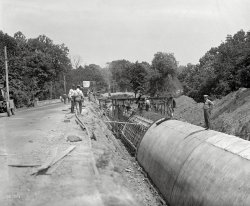
- Traffic Ahead: 1901
- ... Wooden poles were used in the early days, round metal pipe poles with a bell shaped cap were very common, and metal lattice as seen ... Posted by Dave - 01/29/2023 - 3:35pm -
![Traffic Ahead: 1901 Detroit circa 1901. "Woodward Avenue and Farnsworth Street." The future Motor City on the cusp of the Motor Century. 8x10 inch glass negative. View full size.
Re: Pole ClimbingThe town here in Texas where I grew up still had the metal climbing steps on poles in the late 70s, but by then the bottom steps had been raised about 7 or 8 feet off the sidewalk, probably to keep adventurous kids from climbing the poles.
I always wondered what the world looked like from the top of a pole.
Detroit Institute of Artsand the main library, across the street. The only two things on Woodward Avenue that don't make me think I was born 75 years too late.
bjzielinski's Street View is in front of the Maccabees Building, original (radio) home of The Lone Ranger.
Actually, Cater-Corner From the LibraryThis view is looking southeast at the corner of Woodward and Farnsworth. Farnsworth does not extend west of Woodward (the street to the west of Woodward is named Putnam). The future (and current) site of Main Library is thus out of view to the far right of the picture. Similarly, the site of the Detroit Institute of Arts, to the northeast of this corner, is out of view to the far left.
The location shown is now the site of the Horace Rackham Education Memorial Building (opened in 1941), which was originally built for the Engineering Society of Detroit, but is now owned by the University of Michigan and largely leased to Wayne State University.
Previously on ShorpyLooking up Farnsworth in this Kodachrome from 1942. One of the photos that helped get me addicted to Shorpy way back when.
Interesting poles for sureThree quick Shorpy questions:
1. The street lamp almost in the middle of the photo appears to have a pulley and rope, extending down the pole to the street. Is this light now electrified, where its predecessor perhaps was oil-fired, requiring raising and lowering the lamp twice daily for lighting and extinguishing, plus re-filling the oil?
2. The other poles which seem to be handling electricity, also basically in the center of the photo, appear to be metal. since they're honey-combed in the middle. I would have thought wood was the preferred pole material. Were these man-made (and fairly stylish) back in 1901?
3. Finally, I hope someone shows us that intersection today. Bet it looks incredibly different now.
About those polesPower poles could be and WERE made from a number of different materials, although wood was the preferred medium. In western New York, many power poles and street lamp poles from this time period were made from reinforced concrete, which wasn't surprising because the County Engineer "happened" to own a batching plant. But like them or not, they were still usable until the late 1950s and early 60s. The metal poles that replaced them only lasted and twenty to twenty-five years.
Pole ClimbingSome telephone poles still had the climbing steps in them when I grew up on the 50s.
Since then they've discovered climbing spurs.
LibraryIt looks like this photo is looking north along Woodward. If so, then the main branch of the Detroit Public Library was built in the open area to the right of the second house.
Designed by Cass Gilbert, the library was started with a $750,000 gift by Andrew Carnegie. He offered the money in 1901, but the city didn't get around to accepting until 1910. Some things don't change.
Eventually, the houses were replaced by the front lawn of the library, probably when it expanded in the '60s.
Current viewView Larger Map
PolesMark, those are arc lights, which were high maintenance compared to later incandescent and todays bulbs. Note the transformer on the pole just below the attachment of the bracket arm, the wires dropping down to it from the crossarm, and the low voltage wires hanging in a catenary shaped arc to the lamp fixture. Arc lights were much brighter and lower maintenance than oil lights. The carbon rods had to be replaced regularly, but nowhere near the daily schedule required of oil or gas lamps.
Two methods were common for the way to lower the lamps. Often, the metal arm which reached out over the center of the street or intersection would be pivoted to the pole, and the winch would lower the whole arm through an arc to a level where the worker could perform his duties. In this picture, lowering the metal cantilever could interfere with the trolley wires, so the arm was mounted rigidly and the lamp was lowered straight down to service it.
The metal poles in the background were for the trolley line. Wooden poles were used in the early days, round metal pipe poles with a bell shaped cap were very common, and metal lattice as seen in this picture were used to a lesser extent.
Those poles and the pulleyThe metal poles are for the trolley car company's wires. More prosperous lines used metal because it lasted almost forever. Philadelphia still uses some that were erected at the start of electric service in the mid 1890s, although they have received new paint, and some have rusted to death from the inside.
The light on a rope might be an arc light, whose carbons need periodic adjustment. The trolley workers can climb on top of one of their cars to get to their wires in the middle of the street, while the electric company's men climb poles, in this case to disconnect wires so the light can be brought within reach of an adjuster on the ground.
That locationThat location would be Woodward Avenue and Farnsworth Street.
[Incorrect. - Dave]
(The Gallery, Detroit Photos, DPC, Streetcars)](https://www.shorpy.com/files/images/SHORPY_4a03646a.thumbnail.jpg)
- Caught Napping: 1908
- ... something coming out of his mouth. what is it?
[A pipe, among other things. See above. - Dave]
The Sleeping Soldier ... Ewww on the closeup!
Are You Sure That's A Pipe? That looks more like an exploding cigar that exploded while he was ... Posted by Dave - 08/19/2012 - 2:06pm -
![Caught Napping: 1908 Company F, 12th Infantry. Soldiers in their bunks on Governor's Island circa 1908. View full size. 8x10 glass negative, George Grantham Bain Collection.
Soldier A and Soldier Bthe man in the front looks like he is having a great dream, but the man behind him has something coming out of his mouth. what is it?
[A pipe, among other things. See above. - Dave]
The Sleeping SoldierNeatly stacked and secured in the rack next to the sitting (and blurred) soldier are Springfield 1903A1 rifles, I believe. Note also the soldier in the second bunk from the front: asleep with his shoes/boots on. Posed photo, perhaps?
Denny Gill
Chugiak, Alaska
[If he was posing he probably wouldn't be drooling. - Dave]
Can I just say...Ewww on the closeup!
Are You Sure That's A Pipe?That looks more like an exploding cigar that exploded while he was asleep, but still failed to wake him up.
(The Gallery, G.G. Bain, NYC, Patriotic)](https://www.shorpy.com/files/images/01443u.thumbnail.jpg)
- Boston Laundry: 1905
- ... Look closer.
Ceiling Its painted
Horizontal pipe is strange I can't figure out why, that horizontal pipe at the top has an elbow on the left end that seems to be just cut short ... Posted by Dave - 08/24/2011 - 7:53am -
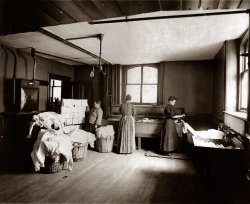
- Delfeld & Son: 1954
- ...
Arrangement of picture Equal red Ridgid three-way pipe threaders are still used. But as every plumber can see, young Paul works ... using it for show and go since late 1989.
Threading pipe I see they are threading galvanized pipe. Not a fun thing to do by ... Posted by Dave - 11/17/2016 - 11:20am -
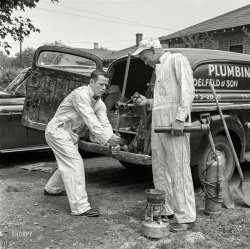
- Our Gang: 1916
- ... in the pavement. This position correlates with the vent pipe seen in the original photo. The corner entrance has been closed and ... Posted by Dave - 10/06/2010 - 6:08am -
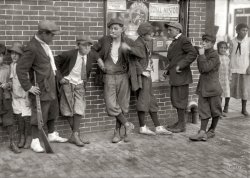
- Sportsmen's Tavern: 1940
- ... button is on his shirt. - Dave]
Put that in your pipe and smoke it Anyone that young smoking a pipe today certainly wouldn't have tobacco in it.
Greco-Italian War The ... Posted by Dave - 01/12/2019 - 10:39am -
![Sportsmen's Tavern: 1940 November 1940. "Having a beer in 'Art's Sportsmen's Tavern' on a rainy day in Colchester, Connecticut." Acetate negative by Jack Delano. View full size.
Who's in retreat?Maybe our history buffs can tell us who is retreating in Athens in November of 1940. Can't read the first word in the Daily News headline.
[ITALIANS. - Dave]
Windows to the PastI found this site comparing past images of Art's with modern views. In the Google Street View it appears to be a pub:
Dude on the left with Jimmy Durante appendage.I'll just bet he honks a symphony whiles he's sleeping.
Election Day?Any ideas on the button the gentlemen man on the left is wearing on his trousers? Something to do with voting/election day perhaps?
[It's a hunting permit. The campaign button is on his shirt. - Dave]
Put that in your pipe and smoke itAnyone that young smoking a pipe today certainly wouldn't have tobacco in it.
Greco-Italian WarThe Greco-Italian War of 1940 was a part of World War II. Fascist Italy invaded Greece from Albania on October 28, 1940. They were repulsed by the Greek Army back beyond the border at some places by November 5. The Italians never got as far as Athens. I think that's where the news was coming from: the Greek command HQ.
Human felicity"There is nothing which has yet been contrived by man, by which so much happiness is produced as by a good tavern or inn." --Samuel Johnson
Which is even truer on a rainy winter's day.
I'll be there in a bitJust let me lace up my boots. Shouldn't take more than 30 minutes.
Arthur Charles Zupnik (1909-1999)Owner (for twenty years) of Art's Sportsmen's Tavern, Justice of the Peace, and charter member of the Colchester Fishing Club. https://www.courant.com/news/connecticut/hc-xpm-1999-01-27-9901270586-st...
I want to be thereSomething about this photo really pulls at me. I want to sit with these guys and just listen to the conversation. I also want a pair of boots like that young man has.
Election DayCampaign button looks more like Wendell Willkie than FDR - certainly not WC Fields!
[It's FDR. - Dave]
(The Gallery, Eateries & Bars, Jack Delano)](https://www.shorpy.com/files/images/SHORPY-8c03777a.thumbnail.jpg)
- Pop with Pipe: c.1963
- ... c. 1963 - Birmingham, Alabama. My dad and his classic "pipe in the mouth" pose, outside our home in North Birmingham.
If I could just see him light up that pipe one more time...
(ShorpyBlog, Member Gallery) ... Posted by Bidcaller - 12/05/2014 - 7:56pm -
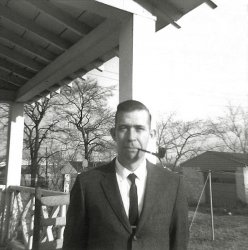
- Second Home: 1943
- ... that in the upper left hand of this photo (near the stove pipe) there's a picture of what appears to be a mother consoling a child.
Penny for his thoughts. Pipe smoker is wearing a Stormy Kromer as well.
I wonder what he's ... Posted by Dave - 07/08/2014 - 12:39pm -
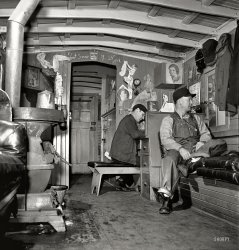
- Grandpa's Pipe
- ... born in 1916, standing on his grandfather's chair with his pipe in his mouth. He lived in Lindenhurst, Long Island, New York at the time. ... Posted by carolelinda - 04/15/2016 - 6:39pm -
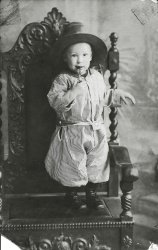
- Members Only: 1910
- ... "Some of the boys working in Phoenix American Cob Pipe Factory. Smallest boy is Joe Krummel. See sign: 'Wanted -- Men and Boys.' ... the classic three-quarters stance; and best of all, Bowtie Pipe voguing a runway pose. Those highwaters are the perfect foundation.
... Posted by Dave - 07/07/2009 - 2:36am -
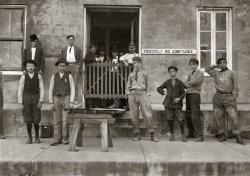
- Kenneth Bell Smoking a Pipe
- Kenneth Bell smoking a pipe. This is sometime around WWII. Exact date and location unknown. Kenneth ... Posted by roguescooter - 09/03/2008 - 3:37pm -
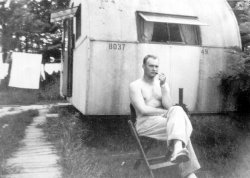
- Indian Orchard Mills: 1911
- ... September 1911. Uncropped full image.
Pipe smoker I love the kid smoking the pipe. Bet it doesn't contain bubble water either.
Indian Orchard Mills I ... Posted by Dave - 07/27/2012 - 9:47am -
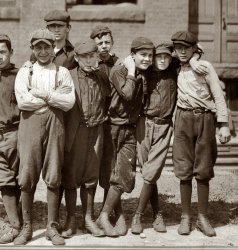
- Sidewalk Squadron: 1942
- ... right a spitting image for my grandmother's house. Same pipe fence around the pride-and-joy 6-foot lawn.
Ahooga I had (actually ... Posted by Dave - 01/19/2023 - 9:26pm -
![Sidewalk Squadron: 1942 July 1942. "Detroit, Michigan. Boys and a girl on bicycles." 4x5 inch acetate negative by Arthur Siegel for the Farm Security Administration. View full size.
Thanks for that caption, FSA!Without it, I would never have realized I was looking at boys and a girl on bicycles.
[The captions are a finding aid for researchers who may not have access to the negatives they describe, or to avoid having to take the negative out of its sleeve, and also because it can be hard to figure out what you're looking at in a negative image. - Dave]
Omira Avenue??Brick house on the right a spitting image for my grandmother's house. Same pipe fence around the pride-and-joy 6-foot lawn.
AhoogaI had (actually still have) one of those horns on my bicycle which I got around 1948. No batteries required and really LOUD.
Captions MatterIn regards to GlenJay's comment: having slogged through 12 linear feet of uncataloged negatives and prints in a local museum, I can verify that even a bare bones caption dramatically reduces a researcher's workload.
Bike BreedsTwo Cleveland Welding Company (CWC) "Roadmaster" bikes (one slightly older) ca. 1937-1941. From the Vintage American Bicycles website, "CWC started producing bikes in September of 1935." The third boy's bike appears to be badged Winton, though that company stopped making bicycles before 1900; but hundreds of badges were placed on various makers' models. Cannot ID the girl's bike, but it is certainly the de rigueur 1940s "girly" color model.
Remember the days when your bike handles fell off and you were left with cold steel?
Bell Bottom BluesSailor, Tuck in those pant legs, or else a member of the Sidewalk Squadron is going to make unwanted contact with it!
Child retirees ??We hear so much about restrictions on automobile tires during the war, but what about bike tires ? Were they similarly rationed, or was it just too minor an issue to bother with? (that would be hard to believe: it's seems like nothing was "too minor to bother with" during WWII.)
Waiting for someone to identify the models: I thought one was a Schwinn, but the spelling is wrong (unless they omitted one of the "N"'s as a wartime economy measure!)
[Roadmaster, Winton, ???, Roadmaster. - Dave]
Rubber shortageGlancing at the front bike tires made me think of rubber rationing and if bike tires were rationed. Of course. Immediately after Pearl Harbor ALL rubber was rationed/banned for most civilian use from tires to hot water bottles to rubber shoe soles.
I had never heard of these but there were Victory Bicycles built during the war to aid with transportation. Less metal by weight, elimination of the frills, small amounts of strategic metals, narrower size tires. Neat photo today that had me diving into bikes in WW2.
Is that a rock?Why hang a rock from your handlebars? And if it's something else -- what is it?
[The girl has one, too! - Dave]
Not an onion, but ...with apologies to Abe Simpson, "So I tied a rock to my handlebars, which was the style at the time!"
My mom (b 1942) told me that in Des Moines in the '50s it was popular for girls to tie a thread around the neck of a dime store chameleon and pin the other end to your blouse so the little lizard could walk around on your shoulders.
Crackerjack outfitThe guy on the left has a sailor hat and bellbottoms. Was there a high school Naval ROTC equivalent at the time?
(The Gallery, Arthur Siegel, Bicycles, Detroit Photos, Kids)](https://www.shorpy.com/files/images/SHORPY-8c28579a1.thumbnail.jpg)
- B&O: 1942
- ... connected to a mechanism within a bracket-mounted box. A pipe passes behind this box, curves down and ends at some hardware located ... Posted by Dave - 12/30/2022 - 10:18am -
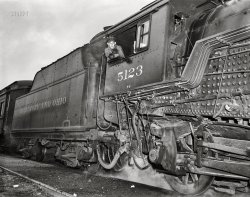
- Watering Hole: 1940
- ... says Eat. Pretty self-explanatory.
Food, Beer and a Pipe Is the guy on the right heading out in a hurry to smoke a bowl/pipe? It looks like a pipe in his hand that he is emptying for a re-fill. If ... Posted by Dave - 03/03/2018 - 12:48pm -
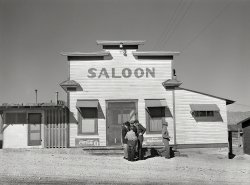
- Nicotine, Caffeine, Gasoline: 1939
- ... pretzel like product.
This could then be grated into pipe tobacco or finer snuff, or cut into ropes and smoked as a crude cigar, or ... as a boy I could have retired much sooner.
Edgeworth Pipe Tobacco Edgeworth Ready-Rubbed, a very nice blend of burley and ... Posted by Dave - 04/07/2018 - 4:50pm -
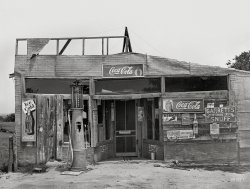
- Newport News: 1941
- ... drawing to the nth degree the placement and bend of every pipe and conduit for his assignment at the time, on submarines. There were ... Posted by Dave - 01/07/2020 - 3:53pm -
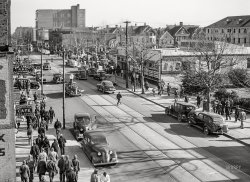
- A Woman and Her Pipe
- The second of a series of images collectively titled "Cabins and Darkeys", taken near Vicksburg, Mississippi and dated February, 1907. These glass "Extra Rapid Dry Plates" were manufactured by the M. A. Seed Dry Plate Co. of St. Louis, Missouri an ... Posted by AllenTenn - 03/23/2012 - 11:49pm -
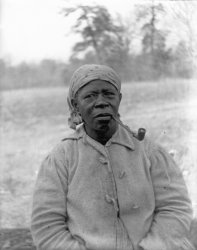
- Lost: 1904
- ... Forgive my automotive ignorance, but what are those six pipe-looking things in front of the steering wheel?
Sweet Ride That's a ... driver"
"If you're so smart, YOU drive"
The pipe things I believe those are sight glasses used to control the flow of ... Posted by bronson - 10/11/2008 - 4:28pm -
![Lost: 1904 July 1904. The Trevor family takes a motor tour of France. Apparently they got lost. View full size.
Pipes?Forgive my automotive ignorance, but what are those six pipe-looking things in front of the steering wheel?
Sweet RideThat's a very nicely built, highly sophisticated car for 1904. I especially like the big horn on the right fender, in case the little one on the left doesn't scare the pedestrians enough. The only thing it's lacking is any attempt at a windscreen.
Who needs a windscreen...... when you can wear one on your head? Quite the attire in the back seat.
Honk HONKI do believe this might be the first example of the famous "Town horn, Country horn."
Other possible titles"Transporting bee-keepers"
"World's first back-seat driver"
"If you're so smart, YOU drive"
The pipe thingsI believe those are sight glasses used to control the flow of oil to various places in the engine.There were a lot of things to do to drive these "old time" cars.
How fastHow fast was this touring car? I can't imagine it going very fast.
What were the tires made of? It looks like they have screws in them to keep them on the wheels.
Was there a trunk of any type?
[Trunks back then were actual trunks strapped to the back of the car. For a discussion of tire clamps see this post. - Dave]
Where it all startedOne of the earliest examples of men not asking for directions.
(ShorpyBlog, Member Gallery, Cars, Trucks, Buses)](https://www.shorpy.com/files/images/trevorsinfrance1904_0.thumbnail.jpg)
- Bleak House: 1940
- ... the Farm Security Administration. View full size.
Pipe dream. I’ve always wanted to purchase buildings like this and fix ... Posted by Dave - 12/18/2019 - 10:54am -
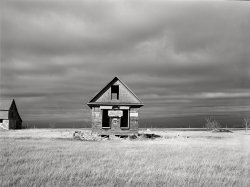
- Aunt Mary's Car: 1920
- ... item. It looks like something on the end of the tail pipe, too. Maybe a warning whistle. It also looks like there is an accessory ... Posted by tterrace - 06/24/2009 - 5:12pm -
![Aunt Mary's Car: 1920 c.1920, in the vicinity of Merced Falls, Calif. My mother's older sister and her car. Maybe someone here can identify it. From original 116 negative. View full size.
Model T Runabout
Mary's CarThe rear license plate seems to say 1928 or 1929---what do others think?
["20." - Dave]
Aunt Mary and Her CarThanks for the auto ID, Anonymous Tipster. As for the date, I'm afraid that Mary died in 1922, of tuberculosis, two weeks shy of her 29th birthday.
Clothes Make The LadySo Aunt Mary was only 26 years old when this picture was taken?
Those clothes make her look at least 50.
Mary's back storyThank you, Aunt Mary's niece, for more about her and her family, poor things. You are right about TB. It was a terrifying disease with an unpredictable but often fatal course. Even worse, there was considerable stigma associated with having it. When my mother-in-law was a child in the 1920s, her father spent several months in a TB sanatorium (he survived, lived a long life and died of something else). She said the children were forbidden to ever speak of it to anyone, for if it was generally known he would lose his job and friends would be reluctant to be with them. She was still uncomfortable talking about it in the 1980s.
Something About MaryShe was a very pretty woman nevertheless.
About Aunt MaryIf this was taken in 1920, Aunt Mary was pregnant with her first child, who was born in October of 1920. What is surprising is that she had her photo taken while pregnant, something most women of that era were too embarrassed to do. (Even in the 1940s our mother was quite chagrined to find out someone took a snapshot of her while she was expecting.)
Aunt Mary's story has an even sadder ending. During her second pregnancy, her tuberculosis, which had been in remission, flared up again, and she died two weeks after the birth of the baby. The baby, being exposed to TB at birth, died of fulminant tuberculosis at age 6 weeks. Mary left a husband and a 2-year-old. Mary was born in June, married in June, and died in June. This was the tragedy of our Mother's family.
We have forgotten today the toll that TB took on people's lives in the early to mid 1900s. Until medication for treatment was developed in the 1940s-50s, TB was one of the top ten killers.
-- Aunt Mary's Niece, who never knew her
Aunt Mary's Clothes"Those clothes" were simply the style of Aunt Mary's era. Yes, today those styles are old-fashioned and pretty silly looking. Just like the clothes we wear today will look old-fashioned and silly looking in 2096 (yes, 2096!). Girls born in 1892 wore those kind of clothes in 1920. Actually, if you take a closer look at Mary, she's pretty easy on the eyes. Some 21st century treatment on her wardrobe, makeup and hair and I'll bet she'd turn a few heads.
TB's Heavy TollMy paternal grandmother contracted TB during my grandfather's courtship of her (started with a cold she got while sitting on the ground watching Granddad play baseball), and died when Dad was 5 (1930). Dad, born with TB, was cured of it at Johns Hopkins during his first 5 years, but still worries about a recurrence to this day- and he's 83 now.
My regret, of course, is that I never got to know my grandmother. Indeed, even my father's memory of her is very sketchy.
Mary's Model TThe car seems to be a ca. 1917-1919 non-starter car. There is an accessory "keyed" ingition switch on the coilbox on the firewall. I put "keyed" in quotes because the stock Ford switch had a key, but they were all the same! I see an electric taillight, which may have been added on. One popular package on 1919 and later cars that had starter motors and generators included demountable rim wheels and an electric taillight. Those cars had no kerosene side lamps. We can't tell if this car has them because of Mary's position. This car does not have demountable rim wheels. The toolbox on the running board is an accessory item. It looks like something on the end of the tail pipe, too. Maybe a warning whistle. It also looks like there is an accessory dashboard, and auxiliary outside brakes on the rear drums. The outside brakes and keyed ignition tell me Mary was a cautious woman.
1917 Model T RoadsterI think the car was a 1917 model year produced around March–April 1917. See the rationale at the Model T Ford Club of America Forum.
Others may see additional items that will alter that recommendation.
Respectfully submitted,
Hap Tucker 1915 Model T Ford touring cut off and made into a pickup truck. Sumter SC.
Merced FallsMerced Falls, 30 miles east of Merced and just a couple of miles south of Snelling, was quite a place in those days. Mostly gold dredging in the Merced River. Not a lot left today. There was a cement factory there also. It was in the foothills of the Sierra Nevada range. There are still a lot of "potholes" filled with water when the dredge would move on to create another hole. The last time I was there (40 years ago) there was still an old dredge in one of the potholes. Great fishing and frogging.
Re Merced FallsMerced Falls was at that time a company lumber town. Aunt Mary was a bookkeeper for the Yosemite Sugar Pine Lumber Company. See her photo with co-workers in "Times of Flu." Aunt Mary and the other unmarried lady employees lived in the Company Hotel. There was housing for families and barracks for the single men. There was a mess hall, pool hall, and a baseball field.
The Lumber company was noted for its Incline Railway system which brought the logs down from the mountains above. The track was 8000 feet long and 3100 feet in height. It started at an elevation of 5000 feet and ended at 1900 ft el. More technical info for train trekkies can be found here.
Aunt Mary married the company town butcher, a young man from a butchering family in England. Later they moved to a house in nearby Snelling. Aunt Mary had moved to Merced Falls from (foggy) San Francisco to live in a drier climate near the mountains, which was thought to be beneficial for tuberculosis. Which it was for a while.
The area today is a county park, the town partly drowned under the waters of Lake McClure, formed by the Merced Falls Diversion Dam.
SnellingMy family has been going to Henderson Park for 50 years especially at Easter.
My uncle Alvin and Grace Halstead have lived near Merced Falls for almost 30 years.
Many great memories of the time spent there.
Tom Mitchell
Killer TBI read with interest the comments on Aunt Mary's pictures and her tuberculosis. Those who wrote that it was a killer are indeed right. My great-grandmother, two great aunts, and one of their sons all died of it within a short time. My grandmother had it when she was pregnant with my mother. She was told that that the baby would either be dead in six months or always immune. Since Mom died at age 72, I guess it was the latter. Her first cousin Edna also had TB and was ill for several years.
The picture is of my grandmother and grandfather in the 1930s. While my grandmother survived TB, she died of a brain aneurysm before I was born.
(ShorpyBlog, Member Gallery, Cars, Trucks, Buses, tterrapix)](https://www.shorpy.com/files/images/marycar2_1.thumbnail.jpg)
- As Advertised: 1939
- ... them, much less create a window display. - Dave]
Pipe tools Those three-part items (reamer, tamper, pick) for 10¢ or 25¢, lower right, between what I take to be zippered pipe/tobacco pouches for a buck.
Box of 25 cigars for 69¢ At that ... Posted by Dave - 05/15/2019 - 8:30pm -
![As Advertised: 1939 Spring 1939. "Drugstore window in Washington, D.C." Medium format acetate negative by David Moffat Myers for the Farm Security Administration. View full size.
Fingers of FearFrom the Amazon description of the book in the display window:
Ruined in the stock market crash of 1929, Selden Seaforth is on the verge of homelessness and starvation when he gets a lucky break: an old school friend, Ormond Ormes, hires him to catalogue the collection of rare books in the library at the mansion of Ormesby.
The mansion has a reputation for being haunted by ghosts, but Seaforth quickly finds out that ghosts are the least of his worries: the house is also inhabited by a bizarre family of madwomen, not to mention possibly vampires, werewolves, and the undead ...
[J.U. Nicolson was evidently big on alliteration. - Dave]
Inflation!I love these old store photos. Shows you how much inflation we have really had.
National brandsI'm not quite 70 but I recognize two products in the window. They're both at left: Lavoris, which I remember as the palatable mouthwash, as opposed to the intensely medicinal Listerine. The other is Castoria, which I vaguely recall, only from TV commercials, as Fletcher's Castoria.
Vitamin GWe call it riboflavin these days.
Not so cheapThe bottle of vitamins at $1.49 would go for almost $26 today, and $18 for the 98 cent pan.
As advertised -- Don't take our word for itOf course everyone will remark on the prices, but I notice there's not a single brand name in the whole store window (not the signs in the window, the window itself) that I recognize and I'm 70, so it's not like they are before my time.
I do like how they have posted the newspaper ad in the window along with the items advertised so that you can know you are getting the advertised price.
I give those 98-cent drugstore frypans about a week to last.
Now if I could just figure out what a "public telephone" was --
Try to find oneA public telephone, that is.
What the world needs... is a good five-cent cigar at 25 for 69 cents!
Related to United Cigars - and Marvel Comics!Interesting history of Whelan Drugs: https://en.wikipedia.org/wiki/United_Cigar_Stores
RelativityAccording to one obscure chart I found, the average annual salary for a public school teacher (for example) in Washington DC in 1939 was $2,350.
[Indeed. Relative to 1939, the number of hours (or minutes) the average person has to work in 2019 to buy something like a toothbrush or a whisk broom is so inconsequential, no store would bother advertising them, much less create a window display. - Dave]
Pipe toolsThose three-part items (reamer, tamper, pick) for 10¢ or 25¢, lower right, between what I take to be zippered pipe/tobacco pouches for a buck.
Box of 25 cigars for 69¢At that price, I’d resume smoking. Also, I’ll take one of those whisk brooms for a dime, please.
A drugstore!!I've noticed Shorpy has not featured drugstore photos recently, so I was delighted to see this one. Thanks! Also, I wonder when "films" lost the "s"? I presume the word refers to the item you put into a camera and took back to have developed.
Another label recognizedI also recognize the Fitch's Shampoo. That line of products was a staple in the barber shop when I was a kid. Fred Fitch also developed one of the first types of anti-dandruff shampoos.
Going Viral From a 1937 TIME magazine article: “The 541 cigar stores of United Cigar-Whelan Stores Corp., which dot the country like an attack of measles, have long been filled to bursting with Mickey Mouse watches, G-Man automatics, shoe trees ... ”
Whelan's Drugs
Such a DealEven adjusted for inflation those whisk brooms are a deal at $1.84 in today's dollars. Cheapest whisk brooms I could find on Amazon cost $4.32.
[$2.83 at Walmart. - Dave]
First EditionsAt least four of the books shown are still in print. I think I have a couple in my library from roughly the date of this photo.
(The Gallery, D.C., David Myers, Stores & Markets)](https://www.shorpy.com/files/images/SHORPY-8b15284a.thumbnail.jpg)
- King of the Road: 1940
- ... scary to think a semi-trailer being pulled by a piece of pipe and a chain.
Pipe and chain The pipe and chain is quite normal and safe. It is part of ... Posted by Dave - 02/17/2018 - 1:45pm -
